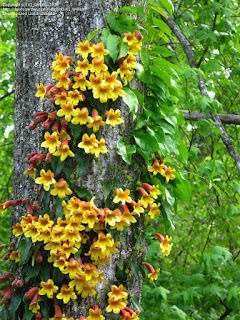It's been a busy week and a half since my last post. One of our sons is in the process of slowly moving into another house. We spent a few hours one afternoon cleaning out some invasive, overgrown English Ivy and other unnecessary plant material. The ivy had actually started growing up between the vinyl siding and the original wood siding of the house, so that was a fun job.
In the process of pulling vines and swinging a brush blade at the growth I managed to pull a muscle in my lower back. It didn't really make itself known until Christmas morning when it began protesting loudly with every little motion. I tried to rest for a couple of days, but now, a week later, I still have pain.
In the meantime I've been cataloging and making plans to get the seeds I've acquired sown. I have nearly forty species to get planted and finally got a few in the soil today.
I used a ten-gallon container to lay out just over three hundred seeds of American Persimmon (Diospyros virginiana) gifted to me by a good friend. I covered the seeds with about a quarter of an inch of clean sand. These large seeds are easier to handle and count than the small seeds that I sow in gallon containers or in individual plug cells.
I've grown a few persimmons from seed in the past, but never in any quantity. I have about 300 seeds left over and, depending on space, I may try to sow another container. One can never have too many persimmon trees!

The small container shown on top of the persimmons are about 100 or so seeds of Nodding Onion (Allium cernuum). This will be my first attempt at starting the onions from seed and I'm hoping for and looking forward to success.
Also sown today were an estimated two to three hundred Eastern Redbud (Cercis canadensis) seeds, started in a five-gallon container. These seeds must be scarified before planting. I did so by pouring boiling water over the seeds then allowing them to cool for about twenty-four hours before sowing.
I'm hoping New Year's Day will allow me to continue to get these seeds in their containers. By getting them in the soil and placing them in a protected area outdoors they should receive adequate cold weather between now and spring to satisfy the needs for proper stratification. The, I look forward to seeing the little seedlings peeking through the soil surface when the weather warms.
My seed collecting will be much more systematic and easier from here on out, and I have my beautiful wife to thank for it. For several years I have been window-shopping for a set of sieves that will filter out the majority of chaff that comes with the territory of collecting seeds. Up until now I haven't made the commitment to purchase a set, but she saw to it that I had a merry Christmas this year. I've already been using the sieves and they, like her, are awesome!
Later in the afternoon, me with my sore back and she with her many joint issues decided to take some time during the beautiful weather and walk a bit on our property behind our home in the Uwharries. Our slow, limping and hobbling pace probably explains why we've started getting the senior discount at some restaurants lately. Either that, or it's my old-man suspenders that I wear now.
As for our walk, there were a few surprises to be found, which I will share in another post.
Thank you for following this adventure and I wish you, dear reader, a successful, green, native 2020.











































